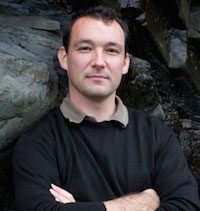Teratoma (noun): derived from the Greek teras, meaning monster; a tumorous clump of otherwise normal body parts—usually hair, teeth, bone.
A teratoma grows inside the body, out of sight, unless it is discovered and excised. Dug out.
Reading Cynan Jones’ lyric and tense fourth novel, The Dig, somehow conjured for me the teratoma. And yet the book—more of a novella, really, at about 150 pages—is immeasurably more grace than gross. It is never lewd or gratuitous. But the visceral language Jones uses, and must use, to unearth this particular story, is a poetic mash-up of the organic: pelt, blood, milk, hair, underbelly, jaw, skin, skull, flesh. Vital fluid, shit, grassdust. Catkin, teeth, sack, vulva, hoof, lanolin, mucus, jissom. Jones holds it up for us to see and handle and inhale: the oily slickness of fresh-born livestock, the rain-logged pastures, the piss-logged bedding straw. “All of these things of life awatered,” he writes. “There is no bucolic pastoral here,” the book jacket rightly forewarns. This is a bantamweight of a book, light on its feet but packing a wallop.
Set in rural Wales, the story is exciting and animalistic, with nary a wasted scene or flashback, nor a word that doesn’t carry its weight. It’s a man’s book. A mother makes a brief appearance, as do memories of a wife, but it is the men whose heads we occupy, whose shovels and steering wheels we grip in our hands. Two men in particular: Daniel, a grieving husband for whom husbandry alone must now suffice in the wake of tragedy, and his counterbalance—a ratter and part-time badger baiter known throughout the story simply as “the big man.”

It is lambing season, and while Daniel labors into the wee hours to bring new life into the world, the big man, with equal constancy, systematically takes life out of it. Both reckon with the land, its beauty and brutality—and also with their own unfortunate histories. Both are avoiding human contact for their own reasons, and yet they collide with each other eventually. Here, even the land has its unhealed scars, and Daniel decides it keeps its own memory, too.
Here is one of many passages that conveys the ineffability of the natural world, and of man’s presence (trespass?) in it:
The owl cut low against the bracken and its wings tilted and it stretched out its furred legs in a way that was somehow catlike and landed on the post and its white also was the very clean white of a cat that has white to it. Then it saw Daniel, and went off over the scrub, leaving the strange white silent thing of itself, like snow can.
Twice in this haunting, fleeting description Jones likens nature to other parts of nature. The owl itself slips deftly in and out of the story as a metaphorical ghost. This seems an inescapable truth of the book: nature is whole unto itself, and true to itself, and nothing else. Certainly not to men, who draw their maps, clear and plow their fields, pit beast against beast for sport, or bring sickly baby lambs into the home in attempts to keep them alive. Stopgaps, Jones’ story seems to say. For of course, men too are a part of nature (perhaps in the same way a teratoma is), and subject to nature’s whims and predations.
At one point, Daniel is looking out over his farm and hears “a noise bearing some primitive hushed whisper of the permanence of vast things.”
Jones got me to hear it, too, for a moment.




